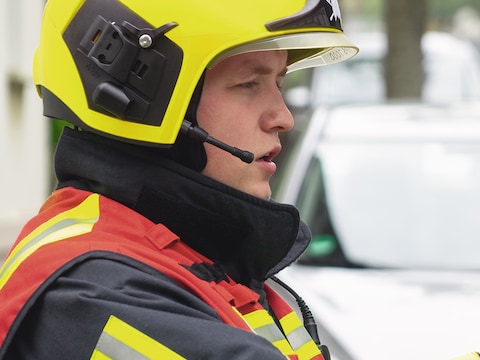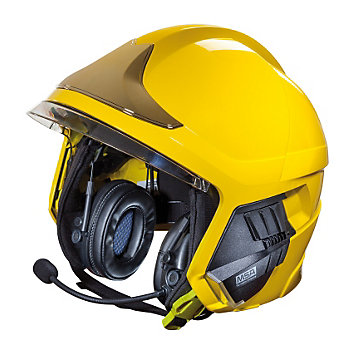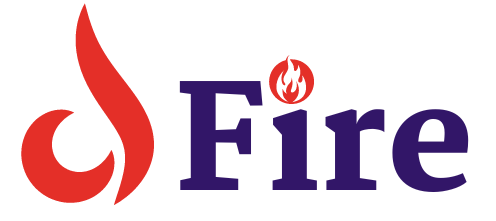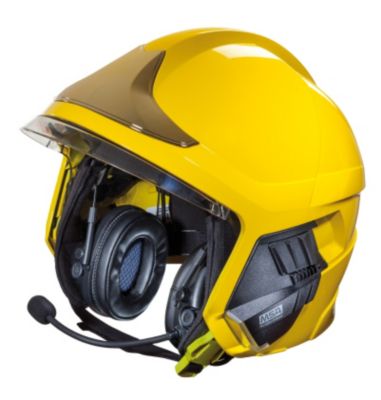A fire fighting helmet with a built-in communication system enhances safety and coordination among firefighters. This innovative gear allows for clear, hands-free communication in hazardous environments.
Advancements in firefighter safety equipment have reached a critical turning point with the integration of communication systems into fire fighting helmets. These specialized helmets are equipped with technology that enables firefighters to stay in contact with their team, even amidst the chaos of battling blazes.
Clear communication is vital in emergency situations, and the introduction of these helmets has revolutionized the way firefighting units operate. Not only do they protect the wearer’s head from impacts and high heat, but they also offer a reliable communication channel that ensures instructions and updates are relayed promptly. This blend of protection and connectivity contributes substantially to the efficiency and safety of fire rescue missions, making it an essential piece of equipment for modern firefighting professionals.

Credit: www.draeger.com
Evolution of Fire Fighting Gear
The Evolution of Fire Fighting Gear showcases a timeline of innovation. From rudimentary tools to advanced technologies, every step taken underscores a commitment to safeguarding firefighters. Their protection gears have morphed through time, embodying progress and safety at the forefront. Today’s gear, notably the fire fighting helmet with built-in communication system, symbolizes the pinnacle of this evolution.
From Leather Buckets To High Tech Helmets
- Early fire fighting relied on simple leather buckets for water transport.
- The introduction of leather helmets offered minimal protection.
- Innovations led to metal helmets, increasing head safety.
- Modern era presents high-tech helmets with built-in communication devices.
Historic Milestones In Firefighting Equipment
| Year | Milestone |
|---|---|
| 17th Century | First leather fire fighting helmets introduced. |
| 19th Century | Steam-powered fire engines began replacing hand pumps. |
| 1960s | Firefighters equipped with self-contained breathing apparatus (SCBA). |
| 2020s | Smart helmets with augmented reality and communication features. |
Importance Of Communication In Firefighting
Effective communication saves lives in firefighting. Clear orders, updates, and alerts are crucial. Firefighting helmets with built-in communication systems revolutionize how firefighters interact. This tech ensures swift, safe rescue operations.
Team Coordination And Incident Command
Commanding officers guide teams through complex situations. Real-time communication helps them manage resources and make decisions. Firefighters depend on it for:
- Navigating emergencies: Knowing who is where and doing what.
- Ensuring safety: Quick updates on risks and evacuation paths.
- Strategy adaptation: Changing tactics instantly when necessary.
Challenges In High-noise Environments
Fire scenes are loud. Helmets with built-in comms overcome noise barriers. They:
| Feature | Benefit |
|---|---|
| Noise-cancelling | Clear messages despite roaring fires. |
| Hands-free operation | Speak and listen without stopping work. |
| Reliable signals | Connect even in building interiors. |
Technical Breakdown Of Comms-integrated Helmets
The cutting edge in firefighter safety gear blends tradition with tech. Modern helmets are not just robust. They now come with built-in communications. Let’s dive into what makes these helmets super smart.
Components Of Built-in Communication Systems
Built-in communication systems are a game-changer. They allow firefighters to stay in touch effortlessly. Essential for making quick decisions on the job. Let’s break down the key elements:
- Mic: Captures voice even in loud environments.
- Speaker: Delivers clear audio to the ear.
- Radio Interface: Connects with standard radios.
- Controls: Easy access, even with gloves.
- Battery: Long-lasting for extended use.
How New Tech Complements Traditional Gear
New technologies in firefighter helmets do not replace old ones. They enhance them. The helmets still
- Protect from impact.
- Shield from heat and water.
- Secure the head firmly.
Communication adds another layer of safety. It lets teams coordinate without delay. Better teamwork leads to better outcomes. Smart helmets are proving themselves on the front lines.

Credit: www.rosenbauer.com
Safety Benefits Of Enhanced Communication
The Safety Benefits of Enhanced Communication cannot be overstated, especially when it comes to firefighting. Traditional helmets protect the head but miss a crucial feature: communication. Introducing helmets with built-in communication systems marks a significant leap in firefighting tactics. This innovative gear enables firefighters to coordinate effortlessly, share vital information quickly, and make instant, informed decisions.
Faster Response And Decision Making
Immediate communication between firefighters translates to quicker response times. In critical situations, seconds matter. A helmet with an integrated system ensures team members stay connected. Clear instructions can be given and received on the go, leading to rapid, decisive actions. Whether it’s navigating through a smoke-filled room or rescuing individuals, enhanced helmets help save more lives.
Reduced Risks Of Miscommunication
Miscommunication in extreme environments is not just inconvenient; it’s dangerous. Built-in communication devices in helmets drastically cut down the chance of messages being lost or misunderstood. Clarity ensures everyone remains on the same page. It’s all about precision and accuracy, from sharing exit locations to signaling distress calls. This reduces errors, enhances team coordination, and boosts overall mission success.
Training For Modern Firefighting Helmets
Training for Modern Firefighting Helmets is essential for fire service personnel to stay ahead of the curve. These helmets are not just protective gear but also high-tech communication hubs. Effective training programs ensure firefighters can fully utilize these advanced tools during emergencies. As technology evolves, firefighters must become adept in the use of sophisticated firefighting equipment.
Adapting To Advanced Equipment
Adapting to new technology is crucial in any field, especially in firefighting. Modern firefighting helmets are equipped with innovative communication systems. These systems enable seamless teamwork in the heat of the action. Firefighters must learn to operate these devices effectively. This requires a foundational understanding of the technology and hands-on practice.
- Review the user manual: Understand the nuances of the helmet’s communication system.
- Hands-on practice: Regular drills using the helmet in a controlled environment.
- Feedback sessions: Discuss experiences and challenges faced during drills.
Scenario-based Learning For Real-world Application
Scenario-based learning bridges the gap between knowledge and practical application. It places firefighters in simulated situations that mimic real-life emergencies. This type of training is vital for mastering modern firefighting helmets with built-in communication systems.
| Step | Scenario-Based Activity |
|---|---|
| 1 | Simulation of a structure fire with live communication. |
| 2 | Navigation through smoke-filled environments using helmet guidance systems. |
| 3 | Coordination drills for team communication in loud settings. |
Firefighters engage in these scenarios to hone their skills. Realistic exercises ensure readiness for any situation. Constant exposure to such training scenarios leads to improved performance and safety.
Integration With Other Firefighting Technologies
Firefighters battle more than just flames. They face extreme heat, smoke, and darkness. It’s vital they have the best tools available. Modern technology in helmets can now talk with other gear. This makes firefighting safer and more efficient.
Helmet Comms And Thermal Imaging
Helmet communications systems work with thermal imaging. They offer critical data. Firefighters see through smoke and darkness with these tools. They identify hotspots and find victims faster.
The integration looks like this:
- Visual Data: Thermal cameras in helmets display heat signatures.
- Audio Clarity: Built-in mics and speakers allow clear team communication.
- Hands-Free: Voice-activated controls make operation seamless.
Linking With Personal Alert Safety Systems
A Fire Fighting Helmet with a Built-in Communication System also links to Personal Alert Safety Systems (PASS). This is crucial for firefighter safety.
| Function | Benefit |
|---|---|
| Location Tracking | Helps find firefighters in distress quickly. |
| Alert Signals | Signals when a firefighter is motionless. |
| Data Sharing | Shares vital signs with command centers. |
This system keeps fighters connected. It ensures no one is left behind.
Case Studies Of Successful Deployments
Fire fighting is a high-risk profession where communication is crucial. Innovative helmets with built-in communication systems are changing how firefighters work. By reviewing case studies, we see the profound impact these helmets have on safety and coordination.
Life-saving Decisions Enabled By Helmet Comms
Firefighting teams in New York City recently adopted helmets with integrated comms. This move drastically improved their operations. Below we explore how communications helmets helped them make life-saving decisions.
- Enhanced Scene Assessment: Commanders got real-time data from fighters, leading to informed decisions.
- Clear Instructions: Firefighters received evacuation orders amidst loud noise, avoiding potential casualties.
- Fast Coordination: Teams coordinated movements in a complex fire, rescuing trapped civilians swiftly.
Review Of Field Performance During Emergency Response
The California wildfires served as a live trial for helmets with comms. Their performance during these emergencies was remarkable. The table below highlights key benefits reported by firefighting units.
| Feature | Benefit | Impact |
|---|---|---|
| Audio Clarity | Commands heard over noise | Reduced confusion |
| Hands-Free Use | Free hands for tasks | Improved efficiency |
| Durability | Resilience in extreme heat | Reliable performance |
These case studies show that helmets with communication systems are more than just gear; they are tools that save lives and enhance firefighters’ ability to perform under pressure. As these technologies evolve, their potential to improve emergency response is boundless.

Credit: gb.msasafety.com
Future Advancements In Firefighting Communications
Now imagine a firefighter racing into a burning building. Their helmet isn’t just a shield; it’s a hub of high-tech communication. Short, clear commands cut through the chaos. This isn’t a scene from the future—it’s the next wave in firefighting technology that we’re anticipating.
Anticipated Developments In Helmet Technology
The firefighting helmets of tomorrow will do more than protect. They will enhance situational awareness. Vision enhances with thermal imaging. Audio clarity brings vital updates. These helmets will guide firefighters through blinding smoke and roaring flames.
- Integrated Heads-Up Displays (HUDs)
- Real-time thermal and gas sensing
- Hands-free communication with voice activation
- Helmet-mounted cameras for remote guidance
Enhancing Durability And Reliability Of Comms Devices
Communication devices must withstand extreme conditions. Future helmets will have rugged comms units. They are water-resistant and heatproof. Upgrades will include:
| Feature | Benefit |
|---|---|
| Long-life batteries | Consistent communication |
| Enhanced signal range | Clearer, farther connections |
| Fail-safes | Back-up channels for safety |
These helmets’ tough shells enshrine state-of-the-art electronics. Firefighters stay connected despite the peril. Every call for help heard, every vital update received—without fail.
Adopting New Standards For Firefighter Safety Equipment
In the world of firefighting, equipment isn’t just about durability; it’s a matter of life and death. Cutting-edge innovations like fire fighting helmets with built-in communication systems are transformative. They are setting new benchmarks in safety and efficiency. These helmets shield firefighters from physical harm and ensure clear communication in the chaos of emergency situations.
Regulations And Compliance For Helmet Communication
Fire fighting helmets must meet rigorous standards. Regular revisions guarantee that helmets provide optimal protection and functionality.
- Communication clarity is a must under noisy conditions.
- They must withstand extreme temperatures.
- Technical compliance with NFPA guidelines ensures uniform safety protocols.
Helmets are tested for impact resistance and audio performance before field deployment.
Incorporating User Feedback Into Design Upgrades
Designers and manufacturers prioritise firefighter feedback. This shapes the evolution of helmet communication systems.
- Helmets are being refined for comfort during long hours.
- Sound quality and noise cancellation features are in constant improvement.
- Feedback leads to better battery life and user-friendly interfaces.
User-centric upgrades push the boundaries of what’s possible in firefighter safety gear.
Frequently Asked Questions
What Helmet Does Fdny Use?
The FDNY uses the Cairns helmet, specifically the model called the Cairns 1044 for their firefighting operations.
What Does A Blue Fire Helmet Mean?
A blue fire helmet typically signifies a firefighter in training or a medical officer within a fire department. Each department may have specific meanings for helmet colors.
What Is The Difference Between Red And Black Firefighter Helmets?
Red firefighter helmets typically signify company officers, whereas black helmets are worn by entry-level or regular firefighters. Helmet colors can vary by department to indicate different ranks or roles.
What Makes A Helmet Nfpa Compliant?
A helmet becomes NFPA compliant by meeting the stringent construction, performance, and safety standards set by the National Fire Protection Association. It ensures reliable thermal protection, impact resistance, and durability for firefighting and rescue operations.
Conclusion
Embracing the merger of technology and safety, fire fighting helmets with built-in communication systems redefine emergency responsiveness. Clear, instant communication is vital in a profession where every second counts. These helmets aren’t just gear; they’re lifelines for heroes. Stay connected, stay safe, and elevate your fire-fighting capabilities to new heights.

I’m Abdus Sobur, a highly skilled and professional Fire Safety Officer with a passion for safeguarding lives and property. Over the course of my career, I’ve conducted numerous successful fire safety audits, earning a reputation for excellence in ensuring public safety.
In addition to my role as a Fire Safety Officer, I’m also dedicated to raising awareness about the importance of fire safety. Through my blog, I share insights into the functions of different fire safety equipment, aiming to empower individuals with the knowledge they need to protect themselves and their communities.
I’m driven by a deep commitment to promoting fire safety awareness and preventing fire-related incidents.

